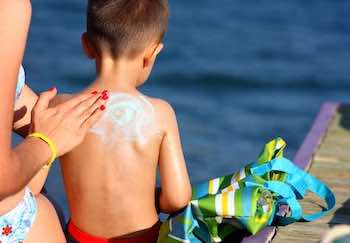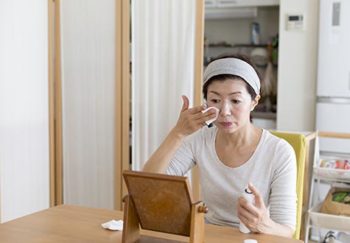
The days are longer and the weather is warmer. People are outside daily, enjoying the warmer months. We wear gloves when gardening, eye protection when cutting wood and face masks when painting. But do we always protect our skin when we’re outside? It’s essential to understand sun safety and decrease your risk of skin cancer with skin protection. One in five Americans will develop skin cancer in their lifetime.
Last year, Hawaii became the first state to pass a law banning sunscreens containing oxybenzone and octinoxate, chemicals that are destroying coral reefs. Mary-Margaret Noland, MD, explains that if you’re concerned about environmental impacts, physical sunscreens can protect you from the sun just as effectively as chemical sunscreens.
Not sure what a physical vs. chemical sunscreen is? Let’s learn the lingo.
Sun Safety Terms
You see these words on your sunscreen, but find out what they really mean for you:
- Broad-spectrum protects your skin from both UVA and UVB rays.
- Chemical sunscreen absorbs into the skin, then has a chemical reaction to protect your skin from the sun rays. This type of sunscreen is more common and popular because it’s easy to apply. You will find avobenzone, oxybenzone and octinoxate in the ingredient list for chemical sunscreens.
- Physical sunscreen sits on top of the skin and has mineral ingredients, such as zinc, that reflect the sun’s rays. This type of sunscreen is not as common as it used to be because it’s harder to blend into the skin and leaves a white residue. Providers recommend physical sunscreen for people with sensitive skin, babies and young children because it has fewer chemicals. Zinc oxide and titanium dioxide are the main ingredients for physical sunscreens.
- SPF stands for sun protection factor, which means how long you can stay outside in the sun without burning. Bring out your calculator for this SPF equation. You take the number of minutes it usually takes you to burn, then multiply it by the number of SPF on your sunscreen to get the minutes of sun protection you should get without burning.
- UVA rays get deeper into the skin, causing wrinkles and age spots.
- UVB rays are harsher on your skin, and leads to burning and skin cancer.
- UPF stands for ultraviolet protection factor, a new system used to measure the effectiveness of fabrics for UV protective clothing.
- Water resistant is the amount of time you can be in the water or sweating before reapplying sunscreen again.
With so many options available, Mark Russell, MD, suggests finding which sunscreen works best for you. Every year, UVA dermatologists host a free skin cancer screening in May. Not only is this an excellent opportunity to check for skin cancer, you’ll get a goody bag of sample sunscreens. Test out the different brands and types to see which one you like best to take on the sun.
Heated Facts About Sun Protection
The goal of sunscreen is to prevent skin cancer, as anyone can get it regardless of your skin color. Dermatologists recommend one ounce of sunscreen, or a shot glass full, to cover exposed areas of the body for proper sun safety.
The American Academy of Dermatology offers other sun safety tips to protect yourself from the sun:
- Avoid prolonged sun exposure from 10 a.m.-2 p.m.
- Wear protective clothing
- Apply a broad-spectrum, water-resistant sunscreen
- Be cautious around water, ice and snow due to the sun reflection
- Avoid tanning beds
We also had some burning questions for our dermatologists:
How often should I reapply sunscreen?
Remember the SPF equation? That should help you determine how frequently you need to reapply sunscreen. But you’ll also need to factor in water. Russell stresses to pay attention to the bottle if it’s water-resistant, as the time may vary from 40-80 minutes for applying more sunscreen.
What is the best way to treat sunburns?
Noland’s quick response — “prevention.” But let’s say you forgot to reapply or you’re sweating a lot, so you get sunburned. She recommends a lot of fluids, moisturizers and anti-inflammatories if needed, for pain and inflammation. For more severe burns, you may need a topical steroid prescribed from your doctor to help with the recovery.
Is higher SPF best for protection?
“Higher SPF may offer better protection, but it’s how well you put it on,” Russell explains. Having the right amount and even distribution of sunscreen on your skin is essential, so lather up.
He also explains different forms of sunscreen:
- Gel sunscreens are easier to apply in the hair, to prevent scalp burns especially in the part of your hair.
- Creams tend to be more popular because they’re easy to spread, but some people might not like having greasy hands afterwards.
- Sunscreen sticks help prevent greasy hands.
- Spray sunscreen is easy, but be careful. If you inhale it, it can irritate the lungs. You’ll still need to rub it in after spraying, making sure you cover all exposed areas.
Got a Weird Spot?
Skin cancer is highly treatable when caught early so schedule your skin cancer examination as soon as possible.
Does UV protective clothing really work?
Actually, UV protective clothing is better than sunscreen, according to Noland. Your basic cotton T-shirt has an UPF 5, but specially-designed protective clothes have UPF 50+ options. The fabric, weave, color and some chemicals factor into the protection. Clothing with a UPF of 50 blocks out 98% of the ultraviolet rays when worn properly.
Washing can wear it down. Noland explains you have around 40 washes before the UV protection becomes ineffective when outdoors. However, this is an excellent option for people who prefer not to use sunscreen or have high sensitivity to the sun.
Does sunscreen expire?
Yes, you can find an expiration date on the bottle of sunscreen, and you should follow it just like you would with food. With expired sunscreen, the ingredients begin to degrade and won’t be as effective on your skin against the sun. “A bottle of sunscreen should only last a week if you’re outside every day and applying appropriately,” Noland explains.

